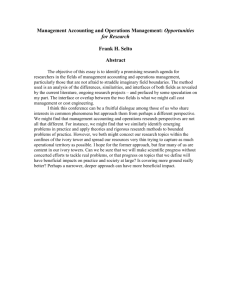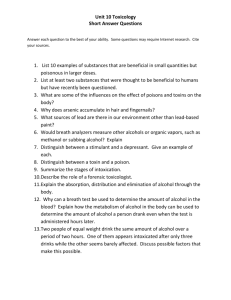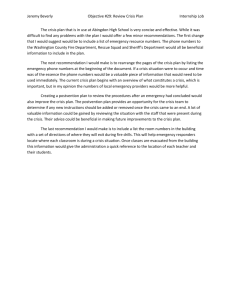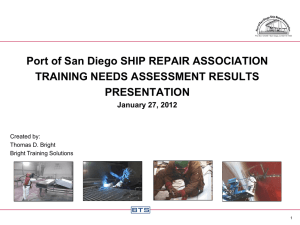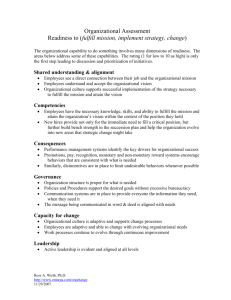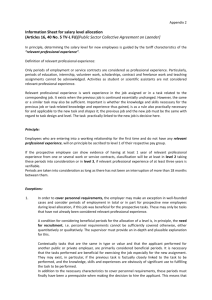Beneficial Ownership Guideline
advertisement
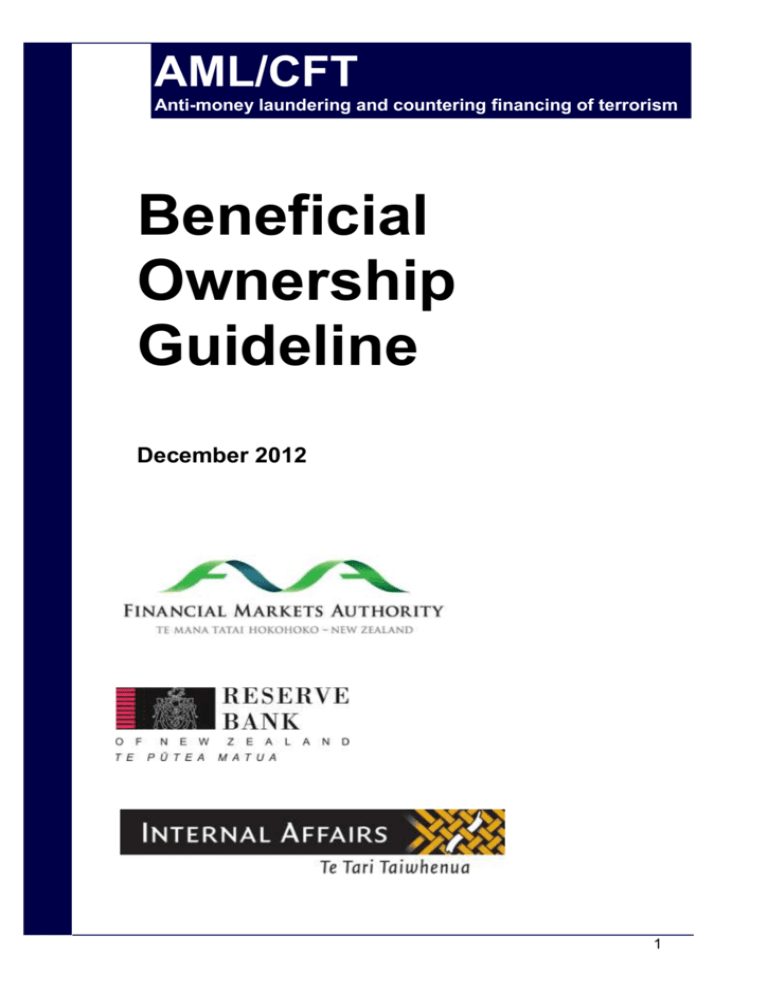
AML/CFT Anti-money laundering and countering financing of terrorism Beneficial Ownership Guideline December 2012 1 Introduction 1. This guideline is to assist reporting entities in meeting the requirement to perform customer due diligence on the customer and beneficial owners of the customer under sections 11-26 of the Anti-Money Laundering and Countering Financing of Terrorism Act 2009 (‘the Act’). 2. A key task is to identify and verify your customers’ beneficial ownership arrangements. It is crucial to know who the beneficial owner(s) are so that you can make appropriate decisions about the level of money laundering and terrorist financing risk associated with your customer. Some criminal enterprises deliberately try to hide the true owners and controllers of their business and its assets. Sometimes identifying and verifying who your customers’ beneficial owner(s) are can be difficult to do. This could be because the ownership structure is complex but legitimate. However, you should remain alert to the possibility that it may be because there is an attempt to conceal the beneficial owner(s). 3. This guideline applies primarily to customers who are legal persons or arrangements. The guideline provides information on how to determine beneficial ownership by identifying the individual(s) that own more than 25 percent of a customer, those with effective control of a customer, and persons on whose behalf a transaction is conducted. 4. Acting on behalf of a customer is not part of the beneficial ownership definition. However, the Act requires reporting entities to also identify and verify those persons. Information on ‘acting on behalf’ is included to help reporting entities understand the distinction between a beneficial owner and a person acting on behalf of a customer. 5. A risk-based approach will allow you some flexibility in the measures you take to verify the identity of the customer’s beneficial owners. Refer to the Identity Verification Code of Practice 2011 for more information on identity verification of individuals in the context of standard customer due diligence. 6. Your evaluation of the money laundering and terrorist financing risks associated with your customer should be based on your risk assessment and complemented by your AML/CFT programme. Refer to the Risk Assessment Guideline and AML/CFT Programme Guideline for information on these obligations. 7. Generally, simplified customer due diligence relates to customers that are already subject to transparency and public disclosure. Be aware that simplified customer due diligence, which in effect means there is no requirement to check beneficial ownership, applies to the limited circumstances specified in the Act1. 8. Examples provided in this guideline are suggestions to assist you in meeting your obligations under the Act, but are not intended as exhaustive examples. 9. This guideline is provided for information only and cannot be relied on as evidence of complying with the requirements of the Act. It does not constitute legal advice from any of the AML/CFT supervisors and cannot be relied on as such. 10. After reading this guideline, if you still do not understand any of your obligations you should seek legal advice, or contact your AML/CFT supervisor. 1 The Act sections 18-21; Regulation 5 of the AML/CFT (Requirements and Compliance) Regulations 2011. 2 What is a beneficial owner 11. The definition of beneficial owner in section 5 of the Act is as follows: Beneficial owner means the individual who – a) has effective control of a customer or person on whose behalf a transaction is conducted; or b) owns a prescribed threshold of the customer or person on whose behalf a transaction is conducted. Our view of what this means is set out in paragraphs 14-16 below. 12. Your obligation is to determine the individual(s) who are the beneficial owner(s). A beneficial owner is an individual (a natural person). Therefore the beneficial owner can only be an individual, not a company or organisation. There may be more than one beneficial owner associated with your customer. Your task is to identify and verify the identity of all the beneficial owners of your customer. 13. If your customer is an individual, section 11(2) of the Act allows you to treat that person as the beneficial owner unless there are reasonable grounds to make you suspect that they are acting on behalf of another. If your customer is acting on behalf of another person, you will need to establish that person’s identity, the beneficial ownership of the customer and any other beneficial owners. Refer to paragraphs 32-36 for more information. The test to identify beneficial ownership 14. Each time you apply the test of beneficial ownership to a customer you must apply three elements. These elements are: a) who owns more than 25 percent of the customer2 b) who has effective control of the customer c) the persons on whose behalf a transaction is conducted A beneficial owner is an individual who satisfies any one element, or any combination of the three elements. 15. You must determine who owns more than 25 percent of the customer and who has effective control of the customer, and also those persons on whose behalf a transaction is conducted. The beneficial owner(s) of your customer may satisfy one or more of the three elements. It is not sufficient to simply apply the ownership element to your customer. 16. There may be individuals who have effective control (see paragraph 23) over the customer, but do not have an ownership interest and are not a person on whose behalf a transaction is conducted; they will be beneficial owners. Effective control, ownership and persons on whose behalf a transaction is conducted are not mutually exclusive. 2 The prescribed threshold under Regulation 2 of the AML/CFT (Definitions) Regulations 2011 should be interpreted to mean owns more than 25%. 3 17. If you want to do business with a customer, you must always identify and verify the identity of the beneficial owner(s). You should establish the customer’s ownership structure and understand the ownership at each layer. The beneficial owner is not necessarily one individual, there may be several beneficial owners in a structure. When there are complex ownership layers and no reasonable explanation for them you should consider the possibility that the structure is being used to hide the beneficial owner(s). 18. In many cases, information will be readily available and quickly provided by your customer. In other cases, you may need to inquire further into a complex ownership or control structure. You may choose to stop at any point in the process, or you may find that the information is unobtainable. However, if you do not identify and verify the identity of the beneficial owner(s), full customer due diligence has not been completed and you must not establish a business relationship or conduct an occasional transaction for the customer (section 37 of the Act). 19. Once you have identified the beneficial owners you have to verify the identity information3. You can apply a risk-based approach to verification. More information is given in paragraphs 32-36 of this guideline. Ownership 20. For the purpose of this guideline, the prescribed threshold should be interpreted as owns more than 25 percent of the customer. 21. You will need to understand the ownership structure of your customer. You should consider that it is possible for ownership to be split into parcels of 25 percent or less, but relationships between the parties may give an individual aggregated ownership of the customer that amounts to more than 25 percent. Diagram 1 – Ownership X Company is directly owned by an individual, Mr. Smith who owns 75% and Y Company which owns 25% and is owned equally by two individuals – Mrs. Jones and Mr. Winston. Establish that this ownership structure is correct. You identify and verify the identity of the individuals who own more than 25% of X Company. In this case, only Mr. Smith owns more than 25% of the customer. 3 Refer to the Identity Verification Code of Practice 2011 for good practice relating to standard due diligence identity verification. A more rigorous approach may be appropriate for higher risk situations. 4 Diagram 2 - Complex ownership X Company has five direct owners each owning an equal amount. Establish that this ownership structure is correct. Two of the five direct owners (D Company and E Company) are wholly owned by Mr. Smith. Identify and verify the identity of Mr. Smith as only he owns more than 25% of the customer. 22. For some customers, when you have applied the beneficial ownership test it will become clear that ownership is spread over a large number of individuals with no individual owning more than 25 percent. For example, a co-operative that has a large number of members is likely to have no individual(s) owning more than 25 percent. In such cases you must still identify a beneficial owner(s). In this case, because no individual(s) own more than 25 percent, the effective control element is more likely to determine the beneficial owner(s). Effective Control 23. Effective control of a customer is part of the beneficial ownership definition. An example is an individual who exercises responsibility for senior management decisions, or similar, of the customer. Do not confuse acting on behalf of the customer with effective control of the customer. 24. Understanding the management and governance structure of your customer will assist you to establish those persons with effective control of the customer. In deciding the effective controller(s) in relation to a customer who is not an individual, you should consider: those individuals with the ability to control the customer and/or dismiss or appoint those in senior management positions those individuals holding more than 25 percent of the customer’s voting rights those individuals (for example, the CEO) who hold senior management positions trustees (where applicable). Some or all of these examples may apply to your customer. You should consider the customer’s management and governance structure and decide who has effective control of the customer. 5 Diagram 3 – Effective control Mr Smith holds all the voting rights for X Company. Mrs Jones has responsibility for all managerial decisions at X Company. In this instance you decide that both individuals meet the beneficial ownership definition because they both have effective control. Person on whose behalf a transaction is conducted 25. Another part of the definition of beneficial owner is a person on whose behalf a transaction is conducted. This may be the individual who is an underlying client of your customer. This concept is important when considering the relationship between managing intermediaries4 and their underlying clients. There are various scenarios, many of which are complicated. A fact sheet will address this and provide more detail on managing intermediaries. 26. An example is, if a reporting entity knows that someone (person A) is conducting an occasional transaction on behalf of another person (person B), then person A and person B should be identified and verified along with any other beneficial owners. 27. Do not confuse persons on whose behalf a transaction is conducted with acting on behalf of a customer. Acting on behalf of a customer 28. This is not part of beneficial ownership; it is part of the customer due diligence obligations under the Act. There are instances where persons are acting on behalf of a customer, but are not necessarily beneficial owners of that customer. 29. Acting on behalf of the customer is when a person is authorised to carry out transactions or other activities on behalf of the customer. ‘Authority to act’ should not be confused with effective control. Sections 16(1)(c) and 20(1) of the Act refer to acting on behalf of the customer. The Act requires you to identify and verify any person who has authority to act on behalf of a customer. An example of this is where a customer has one or more individuals who have authority to sign on accounts or authorise the transfer, sale or purchase of assets owned by the customer. 30. In some instances, funds from an unidentified third party entering and then exiting an account may be reasonable grounds to suspect that a customer is acting on behalf of another. 4Managing intermediaries include managers of managed investment schemes. 6 31. You will need to ask questions where you suspect the customer is acting on behalf of another. Suspicion can emerge when you initially engage with the individual or it can become apparent over time. Applying a risk-based approach 32. The Act allows you to adopt a risk-based approach to how you verify beneficial ownership of a customer. Identifying beneficial ownership of a customer is an obligation that must be satisfied, regardless of the level of risk associated with that customer. However, when deciding what reasonable steps to take to satisfy yourself that the customer’s identity and information is correct, you may vary your approach depending on the risk assessment of the customer. The process for assessing customer risk and deciding how to identify and verify beneficial ownership should be set out in your AML/CFT programme. This must be based on your AML/CFT risk assessment. 33. Where there are reasonable grounds for suspicion of money laundering or terrorist financing, you should apply enhanced customer due diligence and make a suspicious transaction report to the Financial Intelligence Unit (FIU). 34. A risk-based approach allows you some flexibility in your obligation to use data, documents or information obtained from a reliable and independent source to verify the identity of the beneficial owner(s) of your customer. This is applied on a case by case basis. Diagram 4 - A local business In diagram 4, the customer could be a sole trader or a registered company. 7 35. Your risk assessment will set out what you have to do to verify different types of customers. For example, a well known local family business wants to become your customer. You must first identify both the customer and the beneficial owner(s) and obtain standard identity documentation such as passports. Your risk assessment may lead you to treat this customer as lower risk. You may decide that a check in the local business directories, combined with your local knowledge, are reasonable steps. If the customer is higher risk, you may apply enhanced customer due diligence, in which case you must obtain information relating to the source of funds or wealth of the customer (section 23 of the Act). Verification of the identity of the beneficial owner(s) is the last step in the process. To verify the beneficial owner(s) you must obtain appropriate documentation and satisfy yourself that you know who the beneficial owner is (sections 13, 16 and 24 of the Act). 36. It is appropriate for your beneficial ownership identification process to include measures to ensure that you make consistent decisions about customers. This process should be in line with your risk assessment. If the customer is associated with higher risk factors, internal controls in your AML/CFT programme should set out when to escalate decisions to a higher level. For example: sign off for new business; ending existing business; or imposing additional controls for risk management. Record keeping 37. It is good practice to keep detailed records of all decisions and retain customer due diligence and relevant records in a readily auditable manner. It is important for you to record the rationale behind any decision that you make. Anyone reading the notes years later should be able to understand why you made a risk-based decision. 38. This guideline covers the key concepts relating to beneficial ownership and acting on behalf of a customer. Examples of the application of these key concepts to particular situations, or types of customer, will be available as fact sheets. 8
